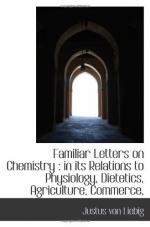Fibrine and albumen, besides having the same composition, agree also in this, that both dissolve in concentrated muriatic acid, yielding a solution of an intense purple colour. This solution, whether made with fibrine or albumen, has the very same re-actions with all substances yet tried.
Both albumen and fibrine, in the process of nutrition, are capable of being converted into muscular fibre, and muscular fibre is capable of being reconverted into blood. These facts have long been established by physiologists, and chemistry has merely proved that these metamorphoses can be accomplished under the influence of a certain force, without the aid of a third substance, or of its elements, and without the addition of any foreign element, or the separation of any element previously present in these substances.
If we now compare the composition of all organised parts with that of fibrine and albumen, the following relations present themselves:-
All parts of the animal body which have a decided shape, which form parts of organs, contain nitrogen. No part of an organ which possesses motion and life is destitute of nitrogen; all of them contain likewise carbon and the elements of water; the latter, however, in no case in the proportion to form water.
The chief ingredients of the blood contain nearly 17 per cent. of nitrogen, and from numerous analyses it appears that no part of an organ contains less than 17 per cent. of nitrogen.
The most convincing experiments and observations have proved that the animal body is absolutely incapable of producing an elementary body, such as carbon or nitrogen, out of substances which do not contain it; and it obviously follows, that all kinds of food fit for the production either of blood, or of cellular tissue, membranes, skin, hair, muscular fibre, &c., must contain a certain amount of nitrogen, because that element is essential to the composition of the above-named organs; because the organs cannot create it from the other elements presented to them; and, finally, because no nitrogen is absorbed from the atmosphere in the vital process.
The substance of the brain and nerves contains a large quantity of albumen, and, in addition to this, two peculiar fatty acids, distinguished from other fats by containing phosphorus (phosphoric acid?). One of these contains nitrogen (Fremy).
Finally, water and common fat are those ingredients of the body which are destitute of nitrogen. Both are amorphous or unorganised, and only so far take part in the vital process as that their presence is required for the due performance of the vital functions. The inorganic constituents of the body are, iron, lime, magnesia, common salt, and the alkalies.
The nutritive process is seen in its simplest form in carnivorous animals. This class of animals lives on the blood and flesh of the graminivora; but this blood and flesh are, in all their properties, identical with their own. Neither chemical nor physiological differences can be discovered.




